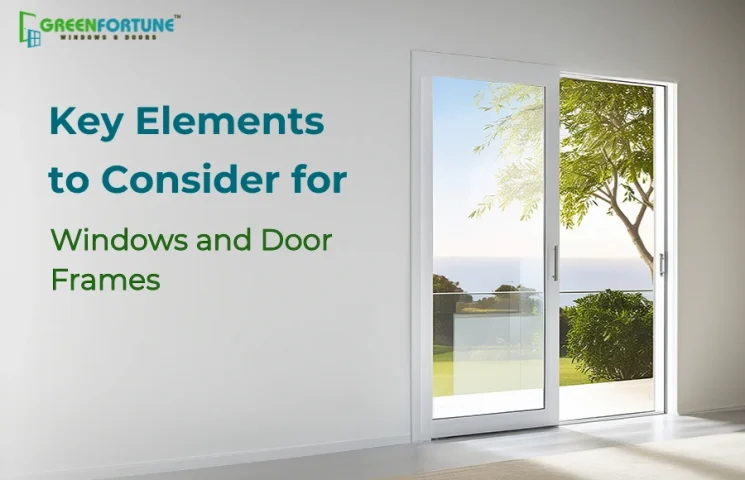
From the lifespan of uPVC windows to their strength, 5 myths about uPVC windows and doors.
September 11, 2024
Custom uPVC Doors: A Comprehensive Buying Guide
September 13, 2024
Good design of door and window frames augments the design of any space. When you design your home or any building of your choice, you should have knowledge of important features in great frame design. Let's look at some of the key aspects that lead to wonderful window and door frame designs.
Material Matters
The frame material most significantly influences a uPVC window frame design durability, appearance, and maintenance requirements. Common materials for windows and door frames include wood, metal, uPVC, and fibreglass, all of which have their distinctive benefits.
Wood
Wooden frames are also going to be good as both options are classic and versatile; a wooden frame can be of a natural, stained, painted, or distressed finish, regardless of style. They are good insulators to maintain inside temperatures, though they require periodic maintenance by repainting or sealing to protect them from moisture and termites. Wood can expand or contract with even the smallest variations in humidity over time, and require more quality and maintenance.
Metal
Aluminium and iron frames provide a slim, contemporary look and are very strong. They are ideal for just the effect of containing the interior and not easily corroding or weathering—great for big weather swings. However, their heat and cold conductive propensity allows for the potential of energy to escape or enter a building. Some metal frames have thermal breaks in the frame that help prevent heat transfer.
Aluminium frames are lightweight yet strong and consequently very favorable for large uPVC window and door frames.
uPVC
uPVC frames are quite popular these days and do not involve high maintenance and are affordable in comparison to wood or metal frames. These frames also come in a tremendous number of fashions and colors. They do provide better insulation than aluminum. Another main advantageous point in favour of uPVC frames is that they have good water resistance, which might help in increased humidity. uPVC does not need painting or staining, and it will not warp or rot like wood does.
Fiberglass
Fiberglass frames are strong and durable, with tensile strength. They conduct low thermal transmission values. They therefore suit all weather conditions and weather temperatures with water content, too. The products come in different types and finishes to cater to many design requirements. They maintain their original form; they do not wrap, rot, nor do they swell in case of weather hostility. With flexibility in any paint color, a fiberglass frame provides good design imitations.
They have high thermal performance that will regulate your indoor temperature and bring low energy costs.
Color Choice
The color design for your uPVC window and door frames should complement the interior and exterior decor of the house. Here are some guidelines for color coordination:
Neutral Tones
Frames in black, white, and natural wood tones are classic and will suit most decorative styles and color schemes. In its neutrality, color offers an uncomplicated and balanced appearance that suits all views of other design elements without dominating them. Black frames give a modern, dramatic look, while white adds freshness and brightness. Natural wood tones provide warmth and create an organically beautiful feel for any room.
Bold Colors
You can also choose windows and door frames in bold colors that contrast or complement the dominant colors of your home's design. Bold frames can be a focal point, drawing emphasis onto some of the architectural details around windows and doors. Consider those that would complement your exterior siding or interior decor to match the view for a cohesive look. Bold colors can also be used to accent entry doors or feature windows, which brings much-needed character and personality to your home.
Proportion and Scale
The size and thickness of uPVC window and door frames should be in scale with the overall dimensions of the structure as well as the space they occupy. Notice:
Balance In this regard, if the window or door is larger, thicker frames are warranted to provide structural soundness and visual balance. Then, slimmer frames will suit smaller openings, and proper proportion ensures that frames set a silhouette for architectural features without overpowering them. Of course, what it means is scaling the surrounding elements against the walls, furniture, other fixtures, or whatever it may be to come up with a look that is harmonious and balanced in its approach.
For instance, a large picture window with a thin frame looks out of proportion, but a sturdy or heavy-weight frame provides better balance in the visual weight and stability of the construction.
Conclusion
Materials, color, proportion, style, and quality make the difference in window and door frames, with a few personal touches added. Bringing attention to these aspects, the prospect of enhanced appearance and functionality of a residence will be well catered to in that every frame will leave beauty or add to its worth.
Discover GreenFortune, Your Partner in Quality uPVC Windows and Doors
At GreenFortune, we are proud to offer high-quality uPVC windows and doors at affordable prices. We offer and install a variety of window types for all homes with both durability and aesthetics in mind.
Contact us to find out more about the uPVC window design that we offer. Whether you are renovating your existing home or building a new one, partner with us to elevate the comfort levels and energy efficiency in addition to the style quotient of your space provided by our superior-quality uPVC windows.
Frequently Asked Question
How Do I Pick the Right Frame Size for My Windows and Doors?
Proper frame size selection balances the dimensions of the openings against the general design. Ensure that frames are balanced with the size of windows and doors and the space around them; especially consider structural support and visual harmony. Provide enough border space or trim around the opening; this contributes to a harmonious presentation. Larger frames would be needed with larger windows or doors since they would have to provide more stability and support, whereas slender frames would strike a delicate balance with smaller openings.
What are the best frame materials, and how have they affected design?
There are clear advantages for all materials or combinations of them: wood, metal, uPVC, and fibreglass. Wood gives an appearance that is timeless with good insulation but boards that need maintenance. Metal offers strength with a slick appearance while possibly affecting energy efficiency. uPVC offers low, easy maintenance, opposite to what fiberglass offers in the way of strength with good insulation. Material selection will impact durability, appeal, and performance.
The choice of material should be based on factors that consider climatic conditions, frequency, needs of maintenance, and scores of aesthetic preference. Quality materials enhance the life expectancy and look of your windows and doors while being in tandem with the design of your home.
How critical is the quality of the framing, and what would I want to look for?
Good-quality framing is important for the life and appearance of your windows and doors. Be sure to know what to look for with solid construction, tight joinery, and glazing appropriate for where you live. Solid frames make all the difference in energy efficiency and add strength and beauty to your home. The frames should be constructed to handle environmental elements like water, thermal stress, and UV exposure. Besides providing aesthetic appeal to the window, high-quality frames prevent drafts and leaks, ensure structural integrity to a great extent, and are comfortable and energy-efficient in terms of an interior environment.








